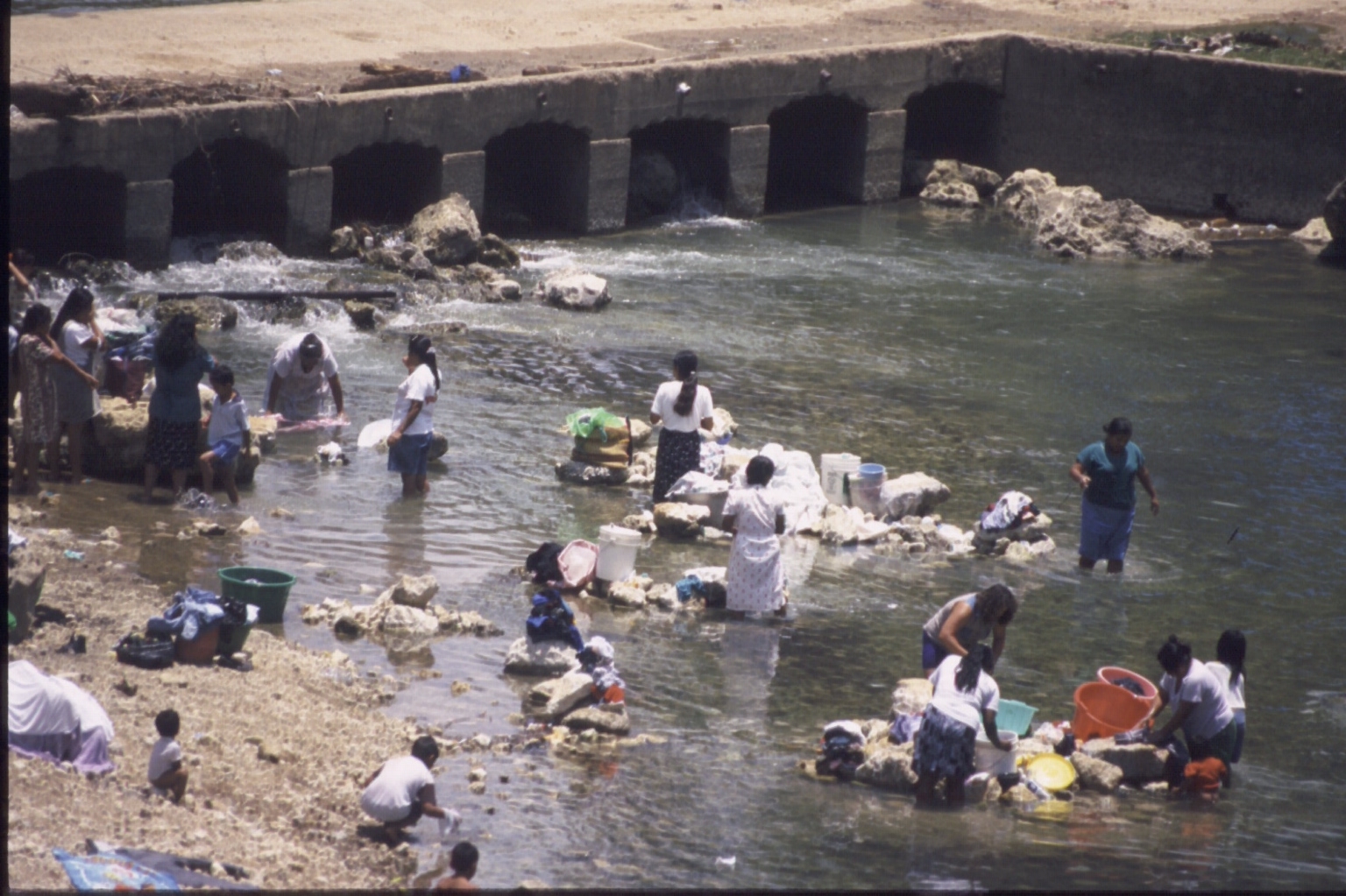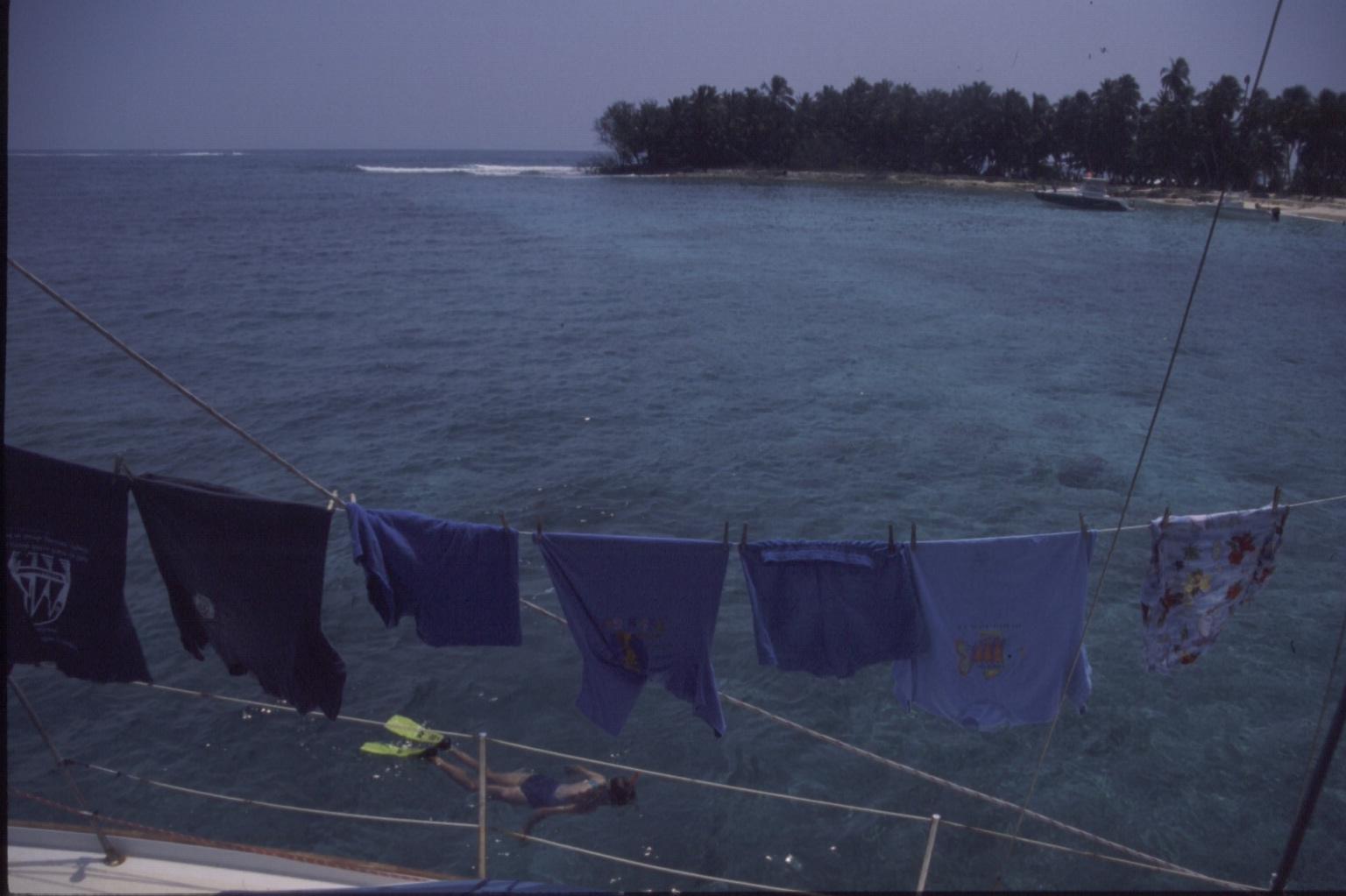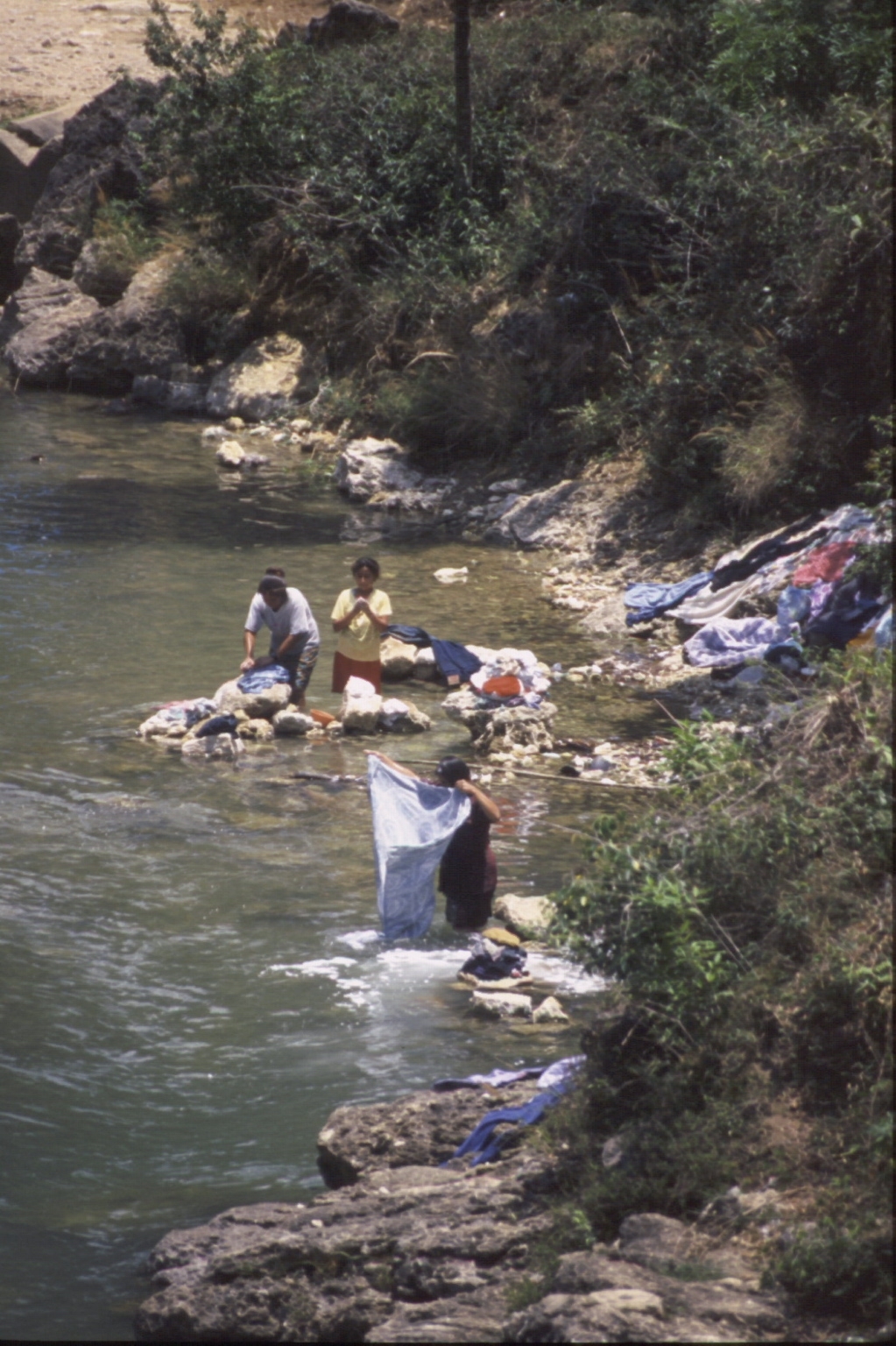
Washday Blues
by Barbara Theisen
I miss my washing machine. After ten years of living aboard with my husband and two daughters, I can still say that I love the cruising lifestyle and there is very little I miss about shoreside life, except perhaps the ease of throwing a load of dirty laundry into a perfectly purring washing machine without ever leaving the house. But, after all of these years, I have found some ways to ease the washday blues.
Sail Naked
Keeping the amount of laundry that piles up to a minimum is the first step to making the washday blues disappear. If, like me, modesty keeps you from sailing naked (those bare French sailors must have no laundry problems) you can still do several things to help.
• Choose fabrics that wash and dry easily. We include plenty of what I call “quick dry” shorts in our wardrobe. These are 100% nylon shorts that are great for the beach, the dinghy, lounging around, sailing, etc. They wash easily and dry in a flash.
• Protect your clothes from salt spray by covering up with foul weather gear or by wearing only a swimsuit or “quick dries” on wet dinghy rides. Part of a cruiser’s life is arriving everywhere with “dinghy butt” and once your clothes get a saltwater bath, nothing but a good wash will make them wearable again.
• Designate a T-shirt and shorts to be your “salt water” clothes for a few days. Wear these over you swim suit when you go to the beach or anyplace they’re bound to become salt encrusted. Hang them on the line to “freshen” a bit over night.
• We like to use our “beach” towels whenever we come out of salt water and our fluffy “bath” towels whenever we are drying off from a freshwater rinse or shower. That way we never have to dry off with a salty towel when we’re “fresh”.
The Wash Cycle
 |
| Mayan Indians washing laundry in a river, Guatemala. |
There are several methods used to hand wash your laundry.
• The Pressure Washer
• The non-electric “Wonder Clean” pressure washing machine is now my preferred method of doing the laundry. It is simple, quick, and uses the least amount of water and laundry soap. The pressure washer can do a “large load” – consisting of about 8 T-shirts or 2 pairs of jeans and uses about 2 quarts of, preferably, warm or hot water (I often heat my water in a solar shower) and 2 TBLS of detergent. Once the water, soap and clothes are in the machine, you tighten the gasketed lid, and crank the handle for about 2 minutes. Pressure builds up in the machine which drives the soap and water into the clothing. Combine this with the agitation from your hand spinning the machine and you get clean clothes. Next you dump out the dirty wash water and add clean water for the rinse. Crank the handle for about one minute, then wring and hang. I can do a couple small loads of laundry quicker than I can bag it up, dinghy to shore and find a laundromat. But more important, I can keep up with the laundry when we’re far from civilization. The pressure washer on its stand is 19” H x 17 ½” W x 12” D with the handle. It is made of molded plastic which won’t rust but you wouldn’t want to drop it from any height. There are no moving parts and no maintenance needed. The Pressure Washer is available from Lehman’s Non –Electric Catalog for about $50 (www.lehmans.com or 1-888-438-5346) or Camping World for about $40 (1-800-626-5944, item # 13309 in their catalog).
• The bucket and plunger
This is a commonly used method for clothes washing and is probably the most effective hand washing method after the pressure washer. Place dirty clothes, water and detergent in a bucket and use a plunger to agitate. If you choose this method you’ll want to spend $10 on a “special” plunger made just for hand washing. Available from Lehman’s Non –Electric catalog (see above) this plunger has internal baffles to help get water and soap into the clothes. Soaking helps get any load of laundry cleaner, so don’t be afraid to let clothes soak.
• The black garbage bag
We’ve used the black trash bag method to wash our clothes many times. It is a simple, cheap way to do laundry. You place dirty laundry, soap and fresh water in a black garbage bag and place on deck in a sunny location. The sun heats the water and the motion of the boat while underway “agitates” the clothes. Unfortunately I seldom do laundry while underway and I find it difficult to agitate the clothes inside the bag otherwise. However it is a practical method for washing large items such as comforters or blankets.
• The washboard
Using a washboard to clean laundry is hard on your clothes and hard on your hands but it is effective for removing dirt. I much prefer one of the above methods.
The Rinse Cycle
• The rinse cycle consists of dumping the dirty wash water, adding clean rinse water and proceeding with which ever of the above methods you prefer (pressure washer, bucket and plunger or black garbage bag). If you are low on fresh water you may want to reuse your wash water for multiple loads of wash - but not for the rinse. Always start with your least dirty clothes and proceed to the dirtiest if you are going to reuse the wash water.
• You may choose to eliminate the rinse cycle by washing your clothes with ammonia instead of laundry detergent. Add about ½ cup of ammonia to your wash water. When you’ve finished washing your load, simply wring and hang. The ammonia will get your clothes clean and does not need to be rinsed out. There will be no ammonia odor left in your clothes. This method will certainly save on fresh water but I prefer to use a more environmentally friendly detergent (see detergent tips below). Do not use ammonia with bleach products.
The Spin Cycle
There are three ways to wring your wet laundry.
• The easiest, quickest and cheapest is to simply wrap your wet clothes around a shroud and twist.
• Hand wringers were made just for this and they do a great job. But they are quite pricey at around $125 (order from Lehman’s Non-Electric Catalog, see above). You will need to find a place to attach the wringer. A sturdy cockpit table might work nice if you find one to fit. I’ve been using the shrouds to hand wring my laundry for the past ten years and can’t find a reason to buy a hand wringer.
• Another way to wring your laundry is to roll it in a clean towel and give it a little twist. This works great for delicates that you’re afraid to wring on the shrouds.
The Dry Cycle
(or the answer my friend is blowing in the wind)
 |
| Our laundry blows in the breeze while anchored at Lime Cay in the Sapodilla Cays, Belize. |
• Hang a clothesline in the rigging to avoid dirty stains your lifelines might leave on the clothes.
• Have a large supply of clothespins. I use wooden ones as the plastic ones seem to get brittle and break with time and I hope that when the occasional clothespin does go overboard, the wooden one will more easily decompose.
I’ve always enjoyed hanging my clothes on the line. A ballet of blue towels dancing on the breeze, the smell of sunshine – no artificial, man-made perfumes from the dryer sheets, and of course a real sense of accomplishment as the clean laundry is hung – the final phase of my washday.
Laundromat Do’s and Don’ts
Here are a few tips when civilization beckons and you choose to use a laundromat.
• First and foremost double bag your clean, dry laundry in sturdy garbage bags for the ride back in the dinghy. A friend once told me that if there was anything he wished he knew before going cruising, that was it. Of course that was just after the laundry he had spent most of the day washing and drying had been hit with a rather large wave on the dinghy ride home.
• Allow for plenty of time at the laundromat and remember to bring a book, your knitting, letter writing material or whatever keeps you busy as you pass the time. In many small communities the water pressure is very low and simply filling your machine may take a half-hour or more. Plan on spending the better part of half a day doing laundry.
• Follow the directions on the machines.
• Don’t forget to clean the lint filters on the dryers.
Detergent Tips
Over the years I have found two laundry detergent methods that I like. They are both economical and easy to store.
• A huge bucket of powdered detergent from Sears cost around $20 and lasts nearly a year for our family of four. The bucket seals well and keeps the detergent from clumping together in the damp marine environment. I would store the big bucket and keep a small supply of the detergent in a clean plastic peanut butter jar with a screw on lid – it was easy to get at and the perfect size for trips to a Laundromat.
• The second method is the one I have been using with my pressure washer for the past couple of years. I use environmentally friendly Simple Green brand concentrated liquid cleaner. With the pressure washer I add only about 2 TBLS of the Simple Green. For ease of use I fill an old dish soap squirt bottle with the Simple Green and just add a squirt (my equivalent of 2
TBLS)
• You can also make your own detergent by mixing 1/8 cup baking soda with 1/8 cup of borax
Leave the Laundry to Someone Else
 |
| Mayan Indians washing laundry in a river, Guatemala. |
In many places around the world you can drop your laundry off and have it done. In Mexico, for example, it’s easy to find a commercial drop-off service that will wash, dry, and fold your laundry very economically. They charge by the pound, and weigh it when you drop it off, so heavy wet towels or clothes really add to the cost. The cost on the Yucatan coast of Mexico ranged from US$2.50 to US$3.50 per 4 kilos. In the Bahamas, you can usually find a woman who does laundry out of her home. We never could get a fixed price ahead of time and we found in the end that it was a bit on the expensive side – around US$8 per load. On the Rio Dulce of Guatemala you’ll find drop-off services at the marinas run a very economical US$2.50 – US$3.00 per load.
On Board Washing Machines
More and more cruising boats are considering the option of having a washing machine on board. Be sure you will be able to meet the requirements of space (approximately 2’W x 3’H x 2’D) where you can permanently install the machine; power (115 volts, 15 amps generally) and water (they average 13-20 gallons per 10 pound load maximum compared to less than 1 gallon used in the hand pressure washer – 5 pound load maximum). Most of the portable machines in use on boats are a combination washer/dryer and cost from $800 to $1,200. Contact West Marine at 1-800-BOATING or www.westmarine.com. or Boat U.S. at 1-800-937-2628 or
www.boatus.com.
I love cruising. This lifestyle allows me plenty of quality family time, the opportunity to travel and the chance to leave the 9-5 rat race behind. But domestic chores can’t be left behind. With four people on board, I find it easiest to keep up with the laundry by doing it on board in small manageable amounts rather than letting it pile up and become such a chore. It’s how I keep the washday blues at bay.
Barbara Theisen has spent the past ten years living aboard Out of Bounds with her husband Tom and daughters, Kate and Kenna. For more information on living the cruising life visit the Theisen’s Website at
www.TheCruisingLife.com.